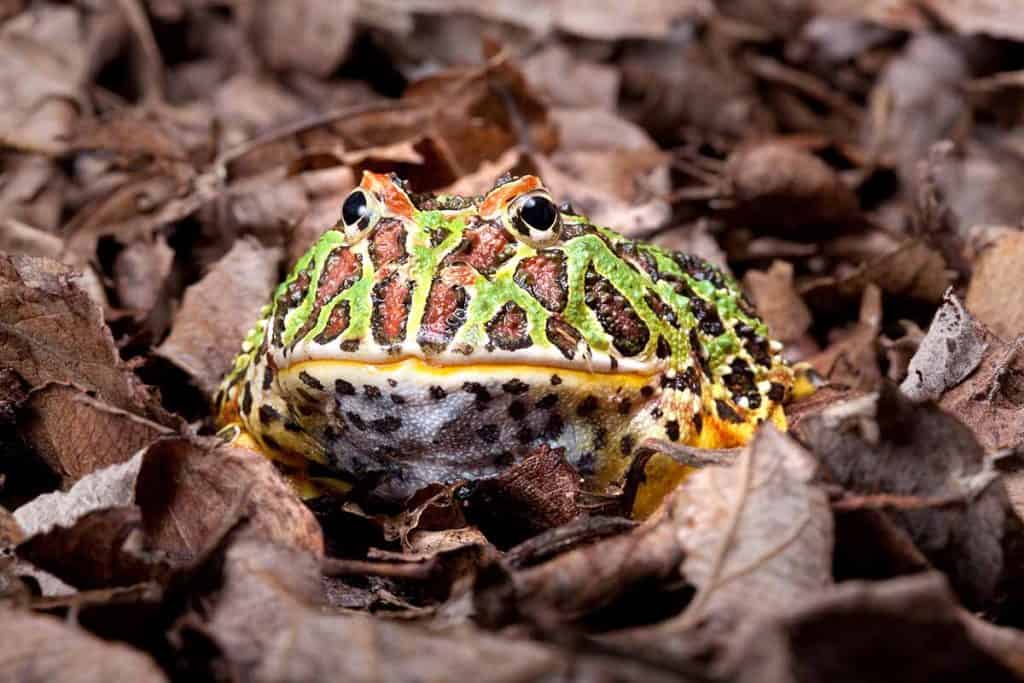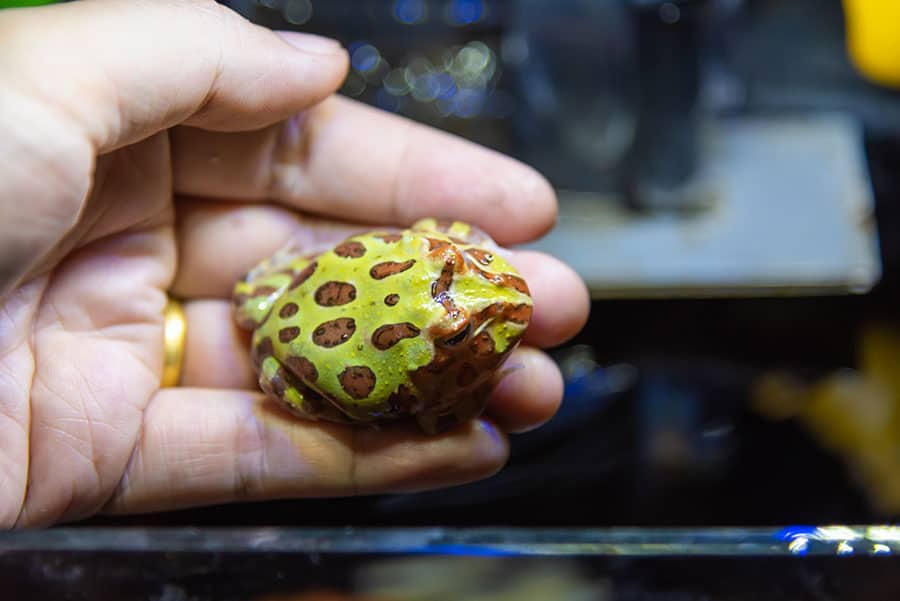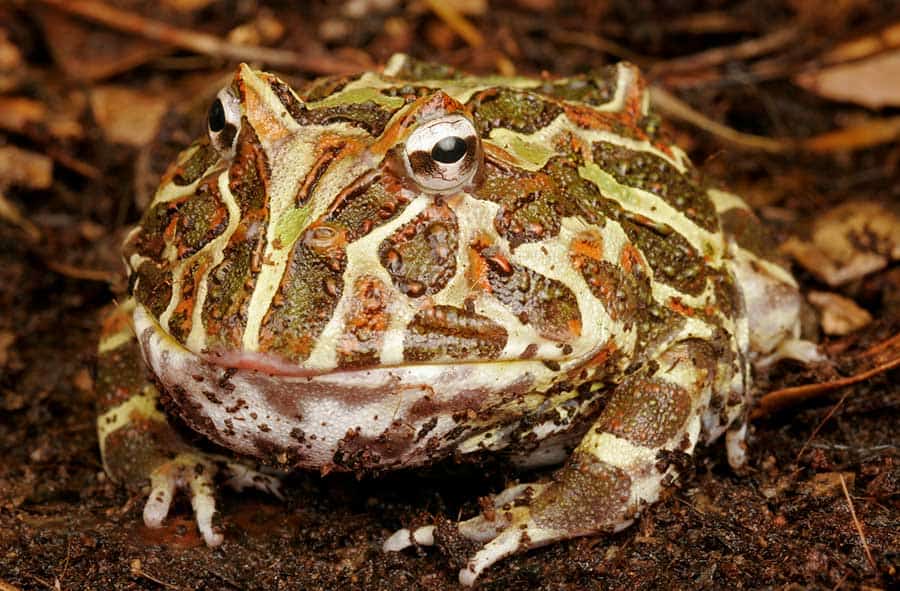Pacman frog care is relatively simple and inexpensive largely because these particular frogs are hardy and can handle some beginner mistakes without suffering too badly. This makes them excellent frogs for beginner amphibian owners!
Caring for a reptile or an amphibian is more complicated than caring for a mammal like a dog or a cat because you need to control their entire environment. Ideally, their captive environment should be as close to their wild environment as possible.
In short, Pacman frogs need to be housed in an adequately-sized enclosure with a species-appropriate substrate. You’ll also need to carefully monitor the enclosure’s humidity, lighting, and temperature settings. Finally, you’ll need to feed your Pacman frog a nutritious diet that is conducive to their health. All of these things, of course, need to be set up and monitored by you!
Read on to find out more about your Pacman frog and how to care for them as responsibly as possible.
Pacman Frogs: A Natural History
Pacman frogs (Ceratophrys ornata) are also known as horned frogs, ornate horned frogs, or South American horned frogs. This is because their eyes are situated very high on their heads and have unique crests that look a little like horns. They get the “ornate” part of their name from their fantastic coloration and patterning.
Most commonly, they are simply called Pacman frogs because their enormous mouths open so wide they resemble the old arcade game character, Pac-Man!
These round, pudgy frogs are native to South America, so they have evolved to live in a warm, humid, tropical environment. This means their enclosure also needs to be very humid in order for them to survive and thrive.
Even though they need a humid environment, these frogs are purely terrestrial and cannot swim well. They love burrowing in the deep, decaying leaf litter on the floors of the South American jungles to keep them moist and warm.
Pacman frogs have quickly become one of the most popular frog species in the pet trade, mainly because they have a purely terrestrial, easy-to-manage enclosure setup and are stunning to look at. Thanks to selective breeding, they’re available in a variety of vibrant colors, such as orange, green, blue, and red, and even a mixture of colors!
These frogs can grow to an impressive 6 inches long! As with many species, Pacman frogs are sexually dimorphic, so there is at least one key physical difference between males and females: their size. Female Pacman frogs are larger than the males.
Behavior and Temperament
Like many amphibians, Pacman frogs are display animals. They are best left in their pretty enclosures and watched for their fascinating behaviors rather than handled.
They are very aggressive towards other animals and are aggressive hunters. Any animal that gets in their way will be quickly devoured by their incredibly large mouths!
Pacman frogs are nocturnal animals, which means they are most active at night. This is the ideal time to watch them move around and explore their environment. However, it’s important to note they are among the least physically active frog species, so they lead a mostly sedentary life.
Enclosure Requirements
As we touched on earlier, Pacman frogs are not very active or energetic animals. This means they do not need to be housed in very large enclosures to feel comfortable and live a happy life. Their enclosure setups are also quite minimal.
Enclosure Size
An ideal Pacman frog enclosure should be between 10 and 20 gallons in size. A 10-gallon enclosure is usually perfectly acceptable, provided it is not too crowded and your Pacman frog is not especially large.
If you have a very large female Pacman frog, then a 20-gallon enclosure may be a more comfortable option, especially if you want to turn it into a bioactive enclosure that has a multitude of live plants and a diverse ecosystem.
Because Pacman frogs are terrestrial, they need enclosures that have more floor space than height. Therefore, when choosing an enclosure, you do not need to select one that is very tall.
Enclosure Type
Pacman frogs need to live in a warm, humid environment at all times. This means using a wooden enclosure is a bad idea because mold and fungus will grow quickly as the wood rots over time. A sturdy, secure plexiglass or glass enclosure is ideal.
Substrate
The substrate is the ‘stuff’ that lines the bottom or floor of your pet’s enclosure. Substrate can be made up of a range of different materials depending on the type of environment you are trying to create in the enclosure.
Pacman frogs need a humid environment, which means they need a substrate that holds moisture well. They also enjoy burrowing in their substrate, so they need something loose and soft they can easily dig into.
Coconut fiber and chips, orchid bark, forest floor bedding, coconut coir, or a bioactive substrate are all excellent choices for the substrate in a Pacman frog’s enclosure. These all hold moisture very well and are easy for Pacman frogs to burrow in. Your substrate should be damp but not soaking wet. If you squeeze a handful of it together, you should not be able to squeeze water droplets out of it.
Your substrate layer should be at least four to five inches deep. This way, your Pacman frog can easily burrow into the substrate and completely submerge themselves in it to keep their temperature stable and their skin hydrated.
If you use a bioactive substrate, then you can plant live plants directly into the substrate and create your own ecosystem! However, if you do not opt for a bioactive setup, then you can simply use little terracotta pots to house the enclosure’s plants.
Plants are an excellent addition to the enclosure because they help keep humidity levels stable and provide your Pacman frog with an attractive, natural-feeling enclosure that provides them with many places to hide, explore, and sleep.
Heating
The best way to heat your Pacman frog’s enclosure is with an under-tank heating pad. These heating pads can provide a stable temperature for your frog without drying out its skin. The heating pad must be connected to a thermostat so you can adjust the temperature as needed.
If you use overhead heating such as a heating bulb, your frog may suffer from dry skin and the health issues that go with that. This type of heating dries out substrate and lowers humidity levels in the enclosure very quickly.
However, if you live in a very cold climate, you may have to use overhead heating as a supplemental heat source. If you need to do this, you will have to monitor the humidity in the enclosure very carefully. Consider either manually misting the enclosure with water yourself throughout the day or using an automatic misting system.
In general, the temperature in the enclosure should sit somewhere between 82°F and 72°F, with it being slightly warmer during the day and cooler at night. The more stable and consistent the temperature is, the better it will be for your Pacman frog. You should measure the temperature with a
Humidity
Pacman frogs need their environment to have very high humidity levels at all times. They need their humidity to constantly sit between 70% to 80% so their skin does not dry out and they do not develop a respiratory infection.
Humidity levels can be achieved and maintained by misting the enclosure daily by hand or by installing an automatic misting system. Having an automatic misting system will ensure the enclosure is at an appropriate humidity level at all times, even if you go away on holiday or forget to mist every so often.
You will need to install a hygrometer in the enclosure to keep track of the humidity levels. If the humidity levels fall too far, your Pacman frog’s skin will dry out, and it will suffer. If the humidity is too high, then your Pacman frog can suffer from a respiratory infection.
Lighting
Pacman frogs are nocturnal. However, they still need a normal day and night light cycle, also known as a photocycle.
You will need to simulate this light and dark cycle by having an overhead light in the enclosure. The light does not need to be any kind of specialized UVB light, as your Pacman frog does not need UVB. However, if you have a bioactive enclosure with live plants in it, then you do need a UVB light in order for the plants to photosynthesize properly.
Your Pacman frog should have 10 to 12 hours of light and 12 to 14 hours of dark every day. This will help simulate a normal day’s rhythm.
Choosing the correct light for the enclosure can be a bit tricky. Additional lights can increase the temperature in the enclosure as well as dry out the humidity. It will take some time for you to figure out what setting the heating pad’s thermostat should be on, what wattage the light should be, and how regularly you will need to mist the enclosure.
To ensure your frog is happy and healthy from the day you bring them home, you should set up their enclosure at least a week beforehand so you can work out all of the kinks related to achieving a comfortable, stable habitat.
Diet and Nutrition
Pacman frogs are carnivores. This means they only eat animal protein. They have voracious appetites and will eat just about anything that moves and is small enough to fit in their gigantic mouths!
In the wild, this behavioral trait of theirs unfortunately often gets them into trouble. Food that fits into their mouths may not necessarily pass through their digestive systems successfully. Therefore, in captivity, you need to make sure any food item you give your frog is no larger than the space between their eyes.
If their food is too large, Pacman frogs can choke or become impacted. Impaction happens when something lodges itself in the intestine and causes a blockage. This kind of blockage can cause sepsis and poison your frog.
Additionally, impaction will prevent your frog from eating, cause it severe pain, and, in many cases, end in death. Some cases of impaction can be treated by vets; however, they often require surgery, and not many vets are willing or able to do surgery on frogs.
Aside from these precautions, though, feeding time can be very fun and engaging for you and your frog! Pacman frogs are enthusiastic eaters, and this behavior is fascinating to watch whether it is the first, fourth, or four-hundredth time you are watching it!
Food Items
Thanks to their healthy appetites, Pacman frogs can be fed a variety of food items.
In general, Pacman frogs enjoy various types of common feeder insects. They can be fed crickets, locusts, grasshoppers, and many different kinds of flies and fly larvae.
Worms are also a good menu item. Phoenix worms, mealworms, nightcrawlers (which are very large earth worms), earthworms, silkworms, and hornworms are all excellent sources of nutrition. These worms can be fed to your Pacman frog as part of their regular diet.
Foods like waxworms and butterworms should be treated as special items and only offered occasionally, as they are very high in fat and can lead to obesity if your frog eats them too often.
Rodents are also on the menu for these hungry amphibians. Pacman frogs can eat small pinky mice! These can provide your frog with a boost in
Feed your Pacman frog as much as they will eat within half an hour, and then remove any leftover items after that.
Water
Pacman frogs do not swim; unfortunately, they are very bad at it! As a result, they do not need an aquatic aspect to their enclosure. However, they do still like to soak their bodies in water from time to time, and they need a place to drink.
Your Pacman frogs should be supplied with a wide, shallow
Common Health Issues
Ammonia Poisoning
If waste products like uneaten insects or feces are left in your frog’s enclosure, the level of ammonia will rise rapidly. Ammonia is toxic, and amphibians are particularly sensitive to ammonia poisoning.
It is essential that you do a daily spot clean of the enclosure to remove all of your frog’s waste products.
Respiratory Issues
If the enclosure is too humid or not humid enough, your Pacman frog can develop a respiratory infection. If your frog develops an infection, you will notice them wheezing, coughing, and drooling. They will also be more lethargic than usual, even if the rest of their enclosure settings are correct.
Skin/Bacterial Infections
If the humidity in your frog’s enclosure is too low, your frog’s skin will dry out. Their skin must be kept moist at all times. Dried-out skin causes microcracks and tears, which are the perfect place for bacterial and fungal infections to grow.
If you notice any swelling, puss, or oozing on any part of your Pacman frog, contact an exotic vet urgently to diagnose and treat the issue.
FAQs About the Pacman Frog
How long do Pacman frogs live?
Pacman frogs live for around 6 years on average in captivity. Sadly, they are not very long-lived pets, but this also means they are the ideal frogs to help you get comfortable caring for amphibians before you potentially move on to more adventurous and challenging frogs, toads, and salamanders!
Can I handle my Pacman frog?
In general, amphibians should not be handled unless it is absolutely necessary. Amphibians have very sensitive, permeable skin. This means anything that touches their skin will make its way to their bloodstream. Frogs are also very sensitive to chemicals and toxins that may appear completely benign to us.
If you need to handle your Pacman frog to move them from one place to another, such as when you are cleaning their enclosure, wash your hands thoroughly with a gentle dish soap and hot water for at least 20 seconds. Keep in mind that once you have washed them, you must rinse them exhaustively so there is no trace of soap on your hands left.
Always wash your hands thoroughly both before and after handling your frog.
Can my Pacman frog bite me?
Pacman frogs are one of the few frog species that have teeth! These teeth help them eat a variety of crunchy insects in the wild. However, it also means they can give you a nasty bite that may even break the skin.
Thankfully, bites are rare and will only happen if your Pacman frog mistakes you for a bit of food. They are fairly mellow and non-aggressive towards humans otherwise. However, they will try to eat anything and everything they can, so you will need to always make sure you have cleaned your hands carefully after handling their food.
How often should I feed my Pacman frog?
Adult Pacman frogs should be fed twice a week. Pick two days of the week, such as Monday and Thursday, and stick to these days to create a routine for your Pacman frog. Consistency will get your frog used to the routine and give them something to look forward to.
Feeding your adult Pacman frog any more than twice a week or so can cause them to become obese very quickly.
Can I house my Pacman frog with other frogs?
Pacman frogs are solitary animals and do not do well with other frogs or animals in the same enclosure. They will attempt to hunt and eat any other animals in the enclosure, including other Pacman frogs!
It is essential that these unique frogs are housed individually to avoid causing them unnecessary stress and to prevent other animals from suffering from their unending appetite!
Hopping Off on Pacman Frogs…
Pacman frog care is enjoyable and simple once you get all the basics down. Their enclosure setup in particular is very manageable because they are terrestrial frogs and do not need a very large water source or much climbing space.
Care to check out another frog species? Here’s an article on how to keep a White’s tree frog.
It is also incredibly rewarding and engaging to keep Pacman frogs because they are beautiful to look at with their range of colors and their interesting behaviors.
Even though they can’t be handled, they still make excellent display pets. With a varied, healthy diet and a suitable enclosure, your Pacman frog will live its best life.




